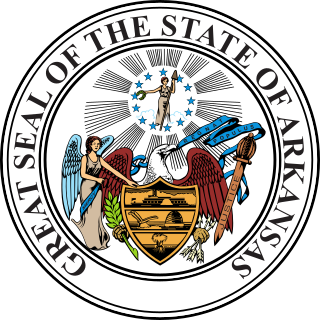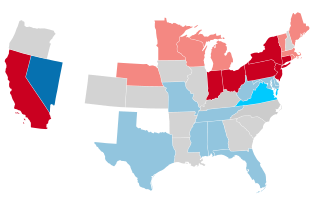
The Vermont General Assembly is the legislative body of the state of Vermont, in the United States. The Legislature is formally known as the "General Assembly", but the style of "Legislature" is commonly used, including by the body itself. The General Assembly is a bicameral legislature, consisting of the 150-member Vermont House of Representatives and the 30-member Vermont Senate. Members of the House are elected by single and two-member districts. 68 districts choose one member, and 41 choose two, with the term of service being two years. The Senate includes 30 Senators, elected by seven single-member and nine multi-member districts with two or three members each. It is the only state legislative body in the United States in which a third party has had continuous representation and been consecutively elected alongside Democrats and Republicans.

The Florida Legislature is the legislature of the U.S. State of Florida. It is organized as a bicameral body composed of an upper chamber, the Senate, and a lower chamber, the House of Representatives. Article III, Section 1 of the Florida Constitution, adopted in 1968, defines the role of the legislature and how it is to be constituted. The legislature is composed of 160 state legislators. The primary purpose of the legislature is to enact new laws and amend or repeal existing laws. It meets in the Florida State Capitol building in Tallahassee.

The California State Senate is the upper house of the California State Legislature, the lower house being the California State Assembly. The state senate convenes, along with the state assembly, at the California State Capitol in Sacramento.

The Colorado State Senate is the upper house of the Colorado General Assembly, the state legislature of the US state of Colorado. It is composed of 35 members elected from single-member districts, with each district having a population of about 123,000 as of the 2000 census. Senators are elected to four-year terms, and are limited to two consecutive terms in office. Senators who are term-limited become eligible to run again after a one-term respite.

The Michigan Senate is the upper house of the Michigan Legislature. Along with the Michigan House of Representatives, it composes the state legislature, which has powers, roles and duties defined by Article IV of the Michigan Constitution, adopted in 1963. The primary purpose of the Legislature is to enact new laws and amend or repeal existing laws.

The Georgia state Senate is the upper house of the Georgia General Assembly, in the U.S. state of Georgia.

The Maryland Senate, sometimes referred to as the Maryland State Senate, is the upper house of the General Assembly, the state legislature of the U.S. state of Maryland. Composed of 47 senators elected from an equal number of constituent single-member districts, the Senate is responsible, along with the Maryland House of Delegates, for passage of laws in Maryland, and for confirming executive appointments made by the Governor of Maryland.

The Connecticut State Senate is the upper house of the Connecticut General Assembly, the state legislature of the U.S. state of Connecticut. The state senate comprises 36 members, each representing a district with around 99,280 inhabitants. Senators are elected to two-year terms without term limits. The Connecticut State Senate is one of 14 state legislative upper houses whose members serve two-year terms; four-year terms are more common.

The Pennsylvania General Assembly is the legislature of the U.S. commonwealth of Pennsylvania. The legislature convenes in the State Capitol building in Harrisburg. In colonial times (1682–1776), the legislature was known as the Pennsylvania Provincial Assembly and was unicameral. Since the Constitution of 1776, the legislature has been known as the General Assembly. The General Assembly became a bicameral legislature in 1791. As of 2024, it is the only state legislature in the country in which Democrats and Republicans each control one chamber.

The Pennsylvania State Senate is the upper house of the Pennsylvania General Assembly, the Pennsylvania state legislature. The State Senate meets in the State Capitol building in Harrisburg. Senators are elected for four-year terms, staggered every two years such that half of the seats are contested at each election. Even numbered seats and odd numbered seats are contested in separate election years. The president pro tempore of the Senate becomes the lieutenant governor of Pennsylvania in the event of the sitting lieutenant governor's removal, resignation or death. In this case the president pro tempore and lieutenant governor would be the same person. The Pennsylvania Senate has been meeting since 1791.

The Delaware State House of Representatives is the lower house of the Delaware General Assembly, the state legislature of the U.S. state of Delaware. It is composed of 41 Representatives from an equal number of constituencies, each of whom is elected to a two-year term. Its members are not subject to term limits, and their terms start the day after the election. The House meets at the Delaware Legislative Hall in Dover.

The Senate is the upper house of the bicameral legislative branch of Liberia, and together with the House of Representatives comprises the Legislature of Liberia. Each of the fifteen counties are equally represented by two senators, elected to serve staggered nine-year terms. The Senate meets at the Capitol Building in Monrovia.

The Arkansas State Senate is the upper branch of the Arkansas General Assembly. The Senate consists of 35 members, each representing a district with about 83,000 people. Service in the state legislature is part-time, and many state senators have full-time jobs during the rest of the year. During the current term, the Senate contains twenty-nine Republicans and six Democrats.

The Alabama State Senate is the upper house of the Alabama Legislature, the state legislature of the U.S. state of Alabama. The body is composed of 35 members representing an equal number of districts across the state, with each district containing at least 127,140 citizens. Similar to the lower house, the Alabama House of Representatives, the senate serves both without term limits and with a four-year term.

The Indiana Senate is the upper house of the Indiana General Assembly, the state legislature of the U.S. state of Indiana. The Senate is composed of 50 members representing an equal number of constituent districts. Senators serve four-year terms without term limits. According to the 2010 U.S. census, the average state senator represents 129,676 people.

The Vermont Senate is the upper house of the Vermont General Assembly, the state legislature of the U.S. state of Vermont. The senate consists of 30 members elected from multi-member districts. Each senator represents at least 20,300 citizens. Senators are elected to two-year terms and there is no limit to the number of terms that a senator may serve.

The Oklahoma Senate is the upper house of the two houses of the Legislature of Oklahoma, the other being the Oklahoma House of Representatives. The total number of senators is set at 48 by the Oklahoma Constitution.

The 1880–81 United States Senate elections were held on various dates in various states, coinciding with the presidential election of 1880. As these U.S. Senate elections were prior to the ratification of the Seventeenth Amendment in 1913, senators were chosen by state legislatures. Senators were elected over a wide range of time throughout 1880 and 1881, and a seat may have been filled months late or remained vacant due to legislative deadlock. In these elections, terms were up for the senators in Class 1.

The 1830–31 United States Senate elections were held on various dates in various states. As these U.S. Senate elections were prior to the ratification of the Seventeenth Amendment in 1913, senators were chosen by state legislatures. Senators were elected over a wide range of time throughout 1830 and 1831, and a seat may have been filled months late or remained vacant due to legislative deadlock. In these elections, terms were up for the senators in Class 3.




















